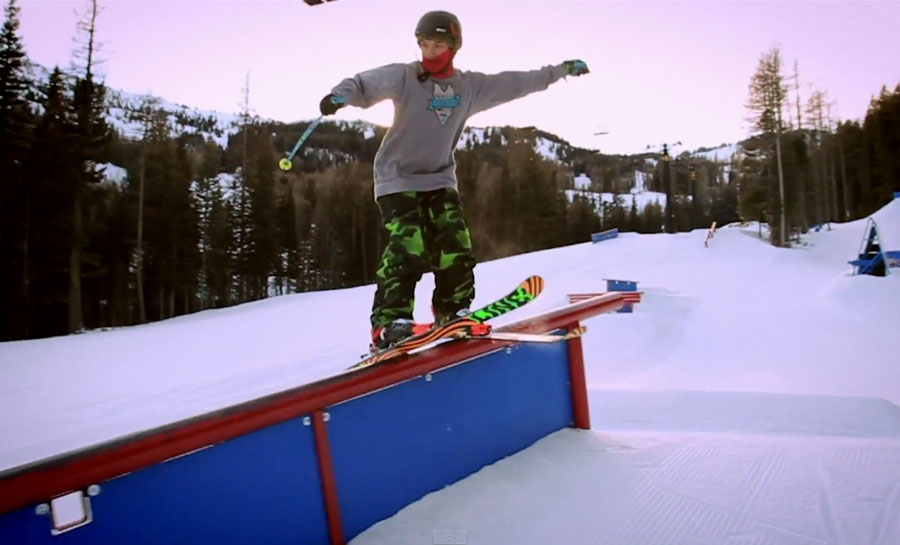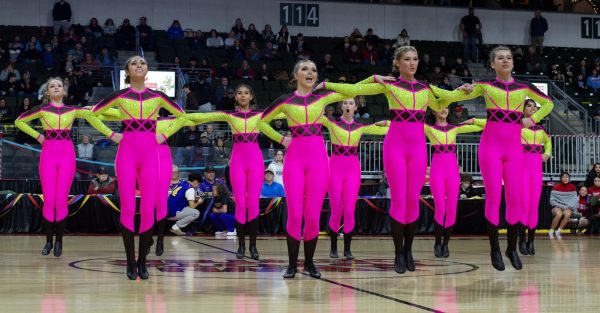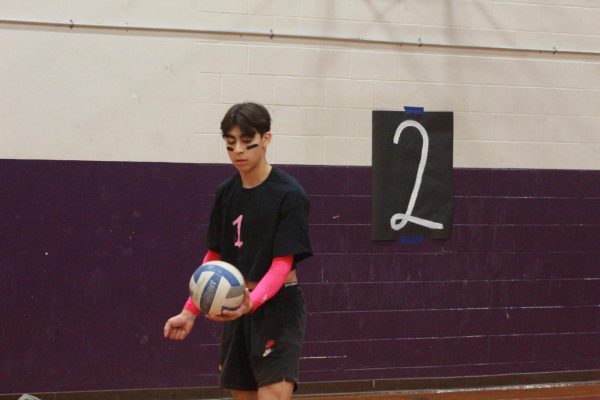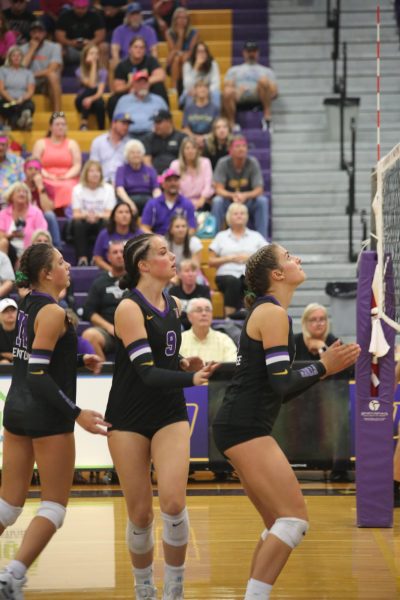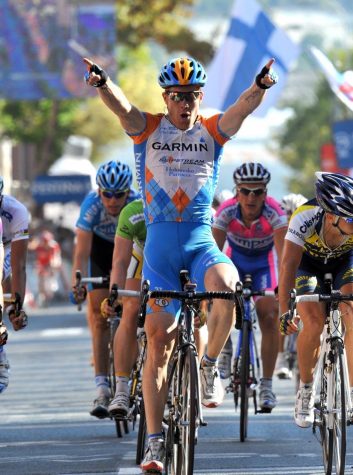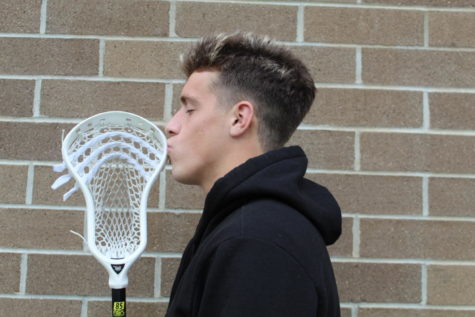Skating and shredding snow
Photo Illustration by Luke Strahm
Sophomore downhill skier Trever Wyles pretzel-grinds a down rail at Mission Ridge’s #100laps terrain park last winter.
Cross Country Skiing
With snow beginning to fall, many students at Wenatchee High School are looking forward to getting on their skis, but a few aren’t going to be using chairlifts or rope tows, they’ll be cross country skiing.
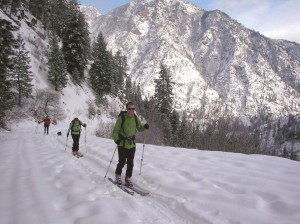
Math teacher Drew Gaylord likes to cross country ski during the winter.
While it may seem crazy to some downhill skiers that people ski uphill for fun, cross country skiing presents a different way to enjoy winter. Rather than tearing by the frosted trees, and spectacular views, you can slow down and enjoy the beauty of winter. “It’s (cross country skiing) a nice way to get out during the winter,” junior Sophie Marshall said. “It’s calming [and] you get to go out into the forest.”
Junior Julia Jobe has been cross country skiing for six years. Both she and Marshall prefer cross country skiing to downhill skiing.
“It’s fun but you also are getting something out of it, whereas downhill skiing you aren’t getting so much exercise,” Jobe said. “I like it better [than downhill skiing] because it’s less expensive.”
“Downhill skiing isn’t as much of a workout. Cross country skiing you’re actually getting more fit and using more energy,“ Marshall said.
Newcomers to the sport often don’t realize that cross country skiing includes two main techniques that are very different: classic skiing, and skate skiing. When classic skiing you are using a running motion to propel yourself. Classic skiers “kick” and “glide” in tracks that are set in the snow by a grooming machine. This technique is considered the easiest to learn, and is most popular among novices.
It’s fun but you also are getting something out of it, whereas downhill skiing you aren’t getting so much exercise.
— Julia Jobe, 11
The second major technique is called skate skiing. Skate skiing is most similar to ice skating or rollerblading. Skiers skate across the snow by “pushing off” and “gliding.” Skate skiing is considered a more difficult technique because it requires more balance and coordination than classic skiing.
Both classic and skate skiing have multiple variations of the basic technique that allow skiers to climb up hills or ski on flats faster and more efficiently.
Classic skis must provide a skier with a way to grip the snow when they are kicking back, yet also must be able to glide. To grip the snow classic skis have either plastic scales or a special sticky wax on the bottom. These grip the snow when a skier puts their weight on the ski and kicks backward, but when the weight is released the ski glides forward freely on the snow.
Skate skis are much simpler in design. The entire bottom of the ski is flat because they are designed to glide on top of the snow, rather than grip it. This is because a skate skier is constantly moving forward, and must be able to glide along the snow.
Unfortunately Wenatchee doesn’t have a cross country ski course. The closest cross country skiing trails are in Leavenworth at the Leavenworth Fish Hatchery (right next to the Sleeping Lady Resort), at the Leavenworth Ski Hill, and at the Leavenworth Golf Course. Leavenworth also has its own cross country ski club, which offers lessons and hosts cross country ski races.
Downhill Skiing
Clouds of light, fluffy powder fly past your head as the skier weaves their way through an untouched path among the trees feeling practically weightless in snow up to their knees. The seemingly endless run of trees and flawless white suddenly reach an end. Instead of stopping they lean forward and bring their body in tight. The ground drops away and they are not falling but airborn, completely free from everything. The view opens up to reveal a sea of white-topped trees, groomers, and chairlifts. They look down and see the slope below fast approaching. Prepared for impact, they penetrate neck-deep into powder and burst out, adrenaline pumping, completely unphased by the drop of more than 20 feet.
This is a thrill any die hard skier thrives for when the clouds open up and dump 30-plus inches of fresh powder.
It’s a nice escape from the city and I get to hang out with people.
— Michael Buehn, 11
“No friends on a powder day” is what sophomore Trever Wyles says when he gets a chance to ski a powder day at Mission Ridge or Stevens Pass. Being a pass-holder of both, Wyles can enjoy a wide variety of terrain, but chooses park skiing as his main passion saying, “I only choose pow over park if it’s good enough.”
Hundreds of skiers can be seen lapping the Mission Ridge terrain park every Saturday. An average terrain park consists of multiple sized jumps and a variety of different shaped metal rails and boxes. Skiers are creative when it comes to hitting features; they can combine different spins and grabs when hopping on or off of a rail to create a new and difficult trick.
These tricks are then shown off at any of the rail jam competitions held anywhere relatively close. Skiers like senior Josh West, sophomore Patrick Tilly, and Wyles, who are sponsored by companies such as Line Skis and Arlberg Sports, travel to compete in these events. Even the average freestyle skier, such as sophomore Dylan Rose, tags along for these events to show off any new skills he’s mastered.
When asked why he park skis Rose said, “I like to shred the gnar with my pals.”
The terrain park isn’t the only place for teenagers to ski. Junior Michael Buehn gets his rush from skiing backcountry through the trees and finding hidden patches of powder.
“It’s a nice escape from the city and I get to hang out with people,” Buehn said.
Even some teachers at Wenatchee High School can be found guilty of taking some runs a few times a week. Math teacher Drew Gaylord spends around 60 days a season either alpine skiing, skate-skiing, or hiking up to backcountry ski. Not only does Gaylord enjoy the adrenaline of skiing, but he enjoys the beauty of the mountains saying, “You get to see things you can’t the rest of the year.”
Junior Grace Vejvoda enjoys a very unique side of skiing, telemarking. Telemarking is a form of skiing when the heels of a boot don’t stay locked down, it is held down by the toe and a lunging movement is necessary to stay in control. It took Vejvoda two seasons to master this style, but once she did she claims it is “more interesting” and is still able to ski the same places as everyone else.
When it comes to snowboarders skiers have a lot of different views. Opinions range from zero discrimination to complete hate such as “snowboarders are abominable snow sliders” as said by Rose.
“The skiing community is much more put together,” freshman Connor Tilly said.
Wyles states that he is “neutral, but I hate people who are bad at either sport.”
For the most part, the stereotype that all snowboarders are drug users and hippies is a myth because the sport has been around for so long that people of all ages snowboard making it nearly impossible to stereotype the entire sport.
A lot of skiers don’t hold a grudge against snowboarders. They happily coexist until one comes along and side-slips down a run of fresh powder, a universal crime shunned by anybody on the mountain.


